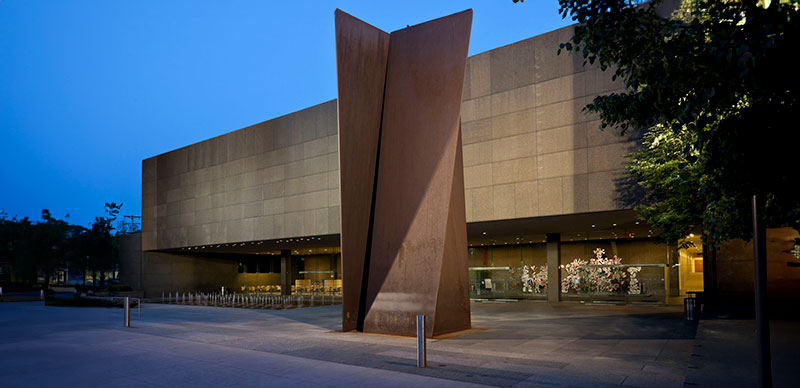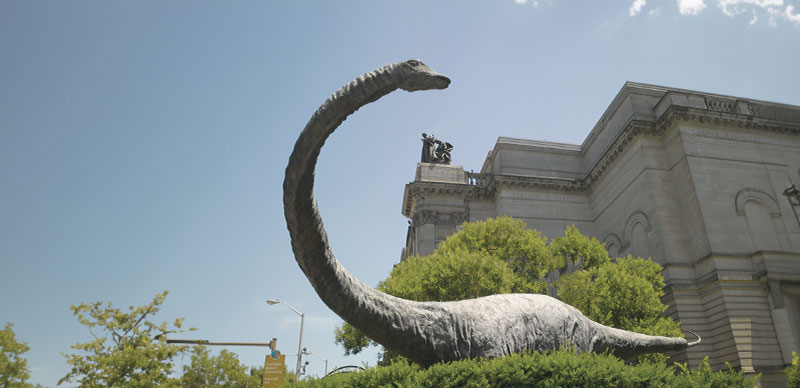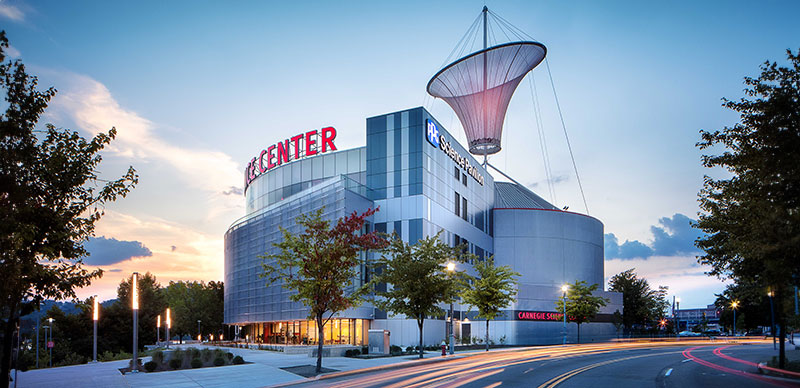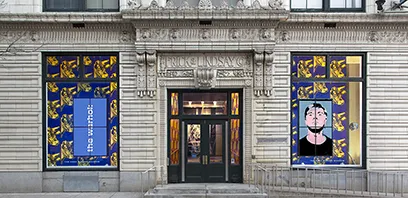Hokusai and Hiroshige
An old man mad about painting vs a master simply true to life
by Sandy Kita and Takako KobayashiNineteenth-century
Japanese “Ukiyo-e” woodblock prints are often called “pictures of the
Floating World”–that is, pictures of the transient world of the actors, courtesans
and rich merchants of the brothel and theater district of the city of Edo, now called
Tokyo. However, Ukiyo-e were far more than scenes of Edo, especially in the hands
of masters such as Utagawa Hiroshige (1797– 1858) and Katsushika Hokusai (1760–1849),
who applied Ukiyo-e’s “fleeting world” perceptions to landscape scenes as
well. When the world of the Ukiyo-e master was confined to Edo’s brothel and the theater
district during Japan’s Tokugawa Period (1615–1868), that is what they drew, but
as their reality broadened, so did their art, until it finally came to portray the
life of the common people of Japan as a whole.
The different approaches of Ukiyo-e artists is nowhere more apparent than in the
development of landscape prints in the 19th century, which reveal how differently
reality could be perceived by masters such as Hokusai and Hiroshige. Hokusai was a
prime example of the independent and bohemian artist, and Hiroshige, 37 years younger,
typified the artist of the establishment point of view. They might view the same scene,
but they would see different things.
Legends about Hokusai tell how he would live in a place, never cleaning it, until
it became so dirty he would have to move. One report describes how an official came
to his house to offer him a commission for a painting, only to find no clean place
to sit. Far from being embarrassed by his wretched housekeeping, Hokusai scolded the
fellow for his lack of manners in not ignoring the mess, and then told him he would
not paint for him unless he apologized and told all who met him that the house of
Hokusai was a model of cleanliness. Legend ascribes over a hundred residences to Hokusai.
He also used nearly a hundred different names. He sometimes signed himself “Old
Man Mad About Painting,” and he must have seemed crazed to some who knew him.
Told to paint red maple leaves floating on the Tatsuta River, Hokusai supposedly drew
a few blue lines on a long sheet of paper and then, dipping the feet of a chicken
in red paint, chased it across the scroll, making the bird’s red footprints his maple
leaves. Japanese art historian John Rosenfeld of Harvard University argues that Hokusai
is the epitome of the eccentric Japanese painter–the artist as outsider and loner.
Hiroshige was much less tempestuous. Born Andô Tokutarô, he was the son of low-ranking
samurai. During the Tokugawa Period the samurai were the middle class, below courtiers
in rank but above commoners. In the stability and peace of the Tokugawa Period the
lesser samurai, like the Ando, ceased to be warriors and became scribes, administrators
and bureaucrats. Hiroshige’s family worked for the fire-fighters league, a job that
Hiroshige inherited at the age of 13 when his father died.
As a low-level bureaucrat, Hiroshige would have found it hard to support himself.
Thus, in 1811, his family apprenticed him to the Ukiyo-e artist Utagawa Toyohiro (1773–1828).
In 1812, Hiroshige received the name Utagawa Hiroshige from Toyohiro, marking his
acceptance into the Utagawa school, the largest in Ukiyo- e. Later, as Hiroshige’s
artistic career developed, he supported himself by selling his art, but even as he
ceased to be a bureaucrat officially, he remained an establishment man, a joiner,
one whose tastes and sensibilities matched those of the group he represented. No other
artist of his time and stature contrasts so strongly to the outsider and loner Hokusai.
Hiroshige himself summed up the distinction between his style of print-making and
that of Hokusai in his inscription on his set of The Hundred Views of Mt. Fuji:
“Katsushika Manji-o [Hokusai] earlier published a set of The Hundred Views
of Mt. Fuji. In this [work], the old man [Hokusai] had drawn grasses, trees, birds,
animals, and other things in his usual talented brush. Also, he had drawn people and
places and their customs. Filled with power of his brush, his work focused upon making
things interesting. For instance, he manipulated Fuji as he liked. My work differs.
I simply reproduce sketches of what I had seen before my eyes.
“This small set of prints is too limited to draw everything in all its details.
So there are many places where I had to abbreviate things, but as much as possible
I made the compositions true to life. For those who can take long trips, please bring
this book along and compare my scenes to the actual scenes. Please forgive the clumsiness
of my technique.”–Ryusai [Hiroshige]
What Hiroshige meant is evident in Hokusai’s print South Wind, Clearing Weather
from his set The Thirty-six Views of Mt. Fuji. The large triangular mass of Mt. Fuji
occupies fully three-quarters of the composition, and it seems all the larger against
the tiny trees below it. The long left slope of Mt. Fuji increases the illusion of
massive scale, as does the mountain’s distinctive, dusky brown color, which gives
the print its popular name, The Red Fuji.
In contrast to that simple, bold image is Hiroshige’s own The Returning Sails at
Yabase from The Eight Views of Lake Omi. Hiroshige’s view contains a complexity of
objects that Hokusai’s The Red Fuji lacks, and the many things to look at in The Returning
Sails allow the viewer’s eye to wander freely through the composition, moving from
one object to the next.
This liberty Hokusai does not accord his audience. The simplicity of Hokusai’s
The Red Fuji forces a focus on the great volcano. He manipulates his audience in a
way that Hiroshige does not.
He also manipulates his subject matter. In some compositions Hokusai relegates
Mt. Fuji to the background, as in The Great Wave off Kanagawa, where a tiny, triangular
Fuji peeks out from beneath the curve of the massive breaker. In other works from
the set a diminished Mt.Fuji appears beneath a bridge, behind trees, or through the
arch of a huge wooden tub that an artisan is constructing.
By contrast, Hiroshige claims that he himself simply reproduced in sketches what
he saw before his eyes, and made his compositions true to life. But this requires
further analysis, for Hiroshige was much more selective than that in arranging his
compositions. In fact, the landscape prints of Hiroshige do not depict exactly what
was before his eyes, although they are a serious attempt to base his composition on
a confrontation with reality. His writings make it clear that he emphasized a direct
experience of the sites that he portrayed, but he does not exercise the “power
of his brush” as Hokusai does. Rather, he is more subtle and passive, sensitively
responding to reality and allowing nature itself to shape the imagery and mood of
his compositions.
Hiroshige does not make “life sketches” in the usual meaning of that
term. In The Satta Pass at Yui from his Fifty-three Stages of the Eastern Sea Road,
he correctly depicts Mt. Fuji rising out of the Izu peninsula with Suruga Bay in front–but
this view is actually impossible to see because of the great distance between Mt.
Fuji and Suruga Bay. Hiroshige’s diaries of his trips to Kazusa, Kai and Mt. Kano
make it clear that he did not design the compositions of his prints on the spot as
a pleine aire painter might. Rather, he sketched as he traveled, using the sketches
like notes to aid his memory later as he designed prints in his studio.
And yet his landscapes are a more revealing record of reality than had been previously
attempted in Japanese art. Many of the places shown by Hiroshige were the “famous
places” (meishô) of Japan–the sites known through history, poetry, literature
and lore. Such meishô often had standardized images to symbolize them, much as the
Eiffel Tower represents Paris. Before this time, Japanese landscape artists regularly
concentrated on the symbols, rather than on the places themselves. For that reason,
it was not necessary for them to actually see the sites that they would draw, for
it was not the geographic reality of a place that counted, but its image in history,
poetry, literature and lore.
Ukiyo-e artists were among the first to break with this tradition of conventionalized
and symbolic portrayals of unseen famous places. The reputed founder of Ukiyo-e, Iwasa
Matabei (1578–1650,) for instance, traveled the Eastern Sea Road, and in his journal
stressed the importance of seeing the meishô for himself. Hiroshige was heir to Matabei’s
method of seeking out the legendary beauty spots of Japan and confronting them in
reality. Diaries of his trips to Kazusa, Kai and Mt. Kano show how seriously he did
that.
Many of his works show an understanding of local customs and lore that he could
only have obtained by examining the sites personally. His Atsuta Festival at Miya
from The Fifty-three Stages of the Eastern Sea Road depicts a horse race–an activity
not mentioned in guidebooks or other writings about Atsuta prior to Hiroshige’s time.
Consequently, many scholars believe that the race was added to the festival only in
Hiroshige’s day.
Similarly, if Hiroshige’s landscapes are not entirely “true to life,”
they are nevertheless geographically instructive. His 1847 triptych The Whirlpools
at Awa, for instance, was considered so precise a rendering of these straits that
the reproduction of this print was forbidden during World War II when the area around
Awa was deemed strategically important for the defense of Japan.
Hiroshige’s accuracy is evident again in The Fifty-three Stages of the Eastern
Sea Road. This set depicts the journey from Edo to Kyoto, reversing the usual order
of the presentation of these sites in travel diaries. The sequence in which the prints
are to be seen is clear, despite the fact that they are not numbered, because Hiroshige
subtitled one image Kanaya: The Far Bank of the Oi River. Kanaya is the distant bank
of the Oi only to those going towards Kyoto.
Thus Hiroshige’s more sensitive and passive responses to recording landscape allowed
nature itself to shape the imagery and mood of his compositions. Whereas Hokusai insisted
on depicting the world in his own individual way, and controlled the viewer of his
compositions, Hiroshige took the public and more common route, and added his genius
to the traditional imagery and actual reality of the Japanese landscape.
Who is to say which Ukiyo-e artist confronts the world with more skill or to greater
effect–an independent Old Man Mad About Painting or a master simply true to life?
Together they show how Ukiyo-e printmaking accommodated contrasting artistic personalities–two
different artists who confronted the “Floating World” and saw different
things.
References
John M. Rosenfield, “Hokusai and Concepts of Eccentricity, “Gian Carlo
Calza, with the assistance of John T. Carpenter, ed., Hokusai Paintings: Selected
Essays, The International Hokusai Research Center, University of Venice, Venice, 1994,
pp. 17-30.
Hiroshi Matsuki, Hiroshige, Hokusai. Tokyo, 1991, p. 64.
The correspondence between Hiroshige’s prints of The Hundred Famous Views of Edo
and the actual sites was recently explored in the exhibition: The Hundred Famous Views
of Edo: Now, Present, and Past (Meishô edo hyakkei shin, ima, mukashi taisho), The
Ota Memorial Museum, 1992.
Takahashi Seiichiro, ed., The Fifty-three Stages of the Eastern Sea Road (Tôkaidô
gojû san tsugi), vol. 14 in Ukiyo-e taikei, Shueisha, Tokyo: 1976, p. 106.
Sandy Kita is assistant professor of Art History at the University of Pittsburgh,
where Takako Kobayashi recently completed her M.A.



